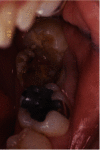Long-Term Outcome of Autotransplantation of a Complete Root Formed a Mandibular Third Molar
- PMID: 34873454
- PMCID: PMC8643253
- DOI: 10.1155/2021/5512804
Long-Term Outcome of Autotransplantation of a Complete Root Formed a Mandibular Third Molar
Abstract
Autogenous tooth transplantation is a procedure to reposition an autogenous tooth to another extraction area or surgically created recipient site. The autotransplantation procedures have been documented well in the literature, and the survival rate of the transplanted teeth was reported to be more than 90% after ten years. Therefore, autotransplantation might have been overlooked as a treatment option. The purpose of this case report is to evaluate the long-term (29-year) success and periodontal stability of the tooth autotransplantation from the mandibular third molar to the second molar. A 24-year old female presented to a clinic with a large caries lesion with periapical radiolucnecy on to tooth #18. The tooth was extracted with the site and treated with autogenous tooth transplantation from #17 with a complete root form. Endodontic treatment was completed 3 months post autotransplantation; the final prosthesis was placed 6 months postoperatively. The patient has shown excellent oral hygiene care and high compliance with the regular maintenance recall program. The transplanted tooth has been still functioning without any symptoms. Radiographic and clinical examinations revealed stable periodontal and endodontic conditions over the 29 years after the procedure. This case report showed the long-term success of autotransplantation of the mandibular third molar with a closed root apex to the second molar site. Autotransplantation can be an option when an adequate donor site is available to reconstruct the occlusion after the tooth extraction.
Copyright © 2021 Hiroyuki Kimura et al.
Conflict of interest statement
There are no conflicts of interest regarding the case presented in this report.
Figures











Similar articles
-
Translational approach to tooth autotransplantation: A 27-year case study.Clin Adv Periodontics. 2024 Sep;14(3):165-171. doi: 10.1002/cap.10272. Epub 2023 Nov 20. Clin Adv Periodontics. 2024. PMID: 37983628
-
Autotransplantation of mandibular third molar: a case report.Case Rep Dent. 2012;2012:629180. doi: 10.1155/2012/629180. Epub 2012 Dec 17. Case Rep Dent. 2012. PMID: 23346422 Free PMC article.
-
Autogenous Transplantation for Replacing a Hopeless Tooth.Iran Endod J. 2017 Winter;12(1):124-127. doi: 10.22037/iej.2017.22. Iran Endod J. 2017. PMID: 28179939 Free PMC article.
-
Does Root Development Status Affect the Outcome of Tooth Autotransplantation? A Systematic Review and Meta-Analysis.Materials (Basel). 2022 May 8;15(9):3379. doi: 10.3390/ma15093379. Materials (Basel). 2022. PMID: 35591712 Free PMC article. Review.
-
Autotransplantation: a lost art worthy of revival in the era of implants.Gen Dent. 2022 Jul-Aug;70(4):28-32. Gen Dent. 2022. PMID: 35749243 Review.
Cited by
-
Should we predict poor prognosis in autotransplantation of teeth with completed root formation?Ann Med Surg (Lond). 2022 Aug 25;81:104501. doi: 10.1016/j.amsu.2022.104501. eCollection 2022 Sep. Ann Med Surg (Lond). 2022. PMID: 36060439 Free PMC article.
-
Autogenous Transplantation of Teeth Across Clinical Indications: A Systematic Review and Meta-Analysis.J Clin Med. 2025 Jul 18;14(14):5126. doi: 10.3390/jcm14145126. J Clin Med. 2025. PMID: 40725820 Free PMC article. Review.
-
Auto-Transplantation of Teeth: A Descriptive Cross-Sectional Study of Knowledge and Attitude.Cureus. 2023 Nov 10;15(11):e48614. doi: 10.7759/cureus.48614. eCollection 2023 Nov. Cureus. 2023. PMID: 38084201 Free PMC article.
-
Autotransplantation of Impacted Third Molars to DCIA Free Flap in Adolescent Patient: A Case Report.Children (Basel). 2025 Mar 16;12(3):370. doi: 10.3390/children12030370. Children (Basel). 2025. PMID: 40150652 Free PMC article.
-
Case of Pulp Regeneration Following Autologous Transplantation of an Incompletely Rooted Tooth.Case Rep Dent. 2025 Apr 8;2025:7121013. doi: 10.1155/crid/7121013. eCollection 2025. Case Rep Dent. 2025. PMID: 40291614 Free PMC article.
References
Publication types
LinkOut - more resources
Full Text Sources
Miscellaneous

